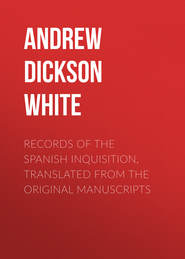По всем вопросам обращайтесь на: info@litportal.ru
(©) 2003-2025.
✖
The Warfare of Science
Настройки чтения
Размер шрифта
Высота строк
Поля
For opinion of Basil, Ambrose, and others, see Lecky, Hist. of Rationalism in Europe, New York, 1872, vol. i., p. 279, note. Also, Letronne, in Revue des Deux Mondes, March, 1834.
6
For Lactantius, see Instit., iii., 24, translation in the Ante-Nicene Library; also, citations in Whewell, i., 196, and in St. Martin, Histoire de la Géographie, pp. 216, 217. For St. Augustine's opinion, see the Civ. D., xvi., 9, where this great Father of the Church shows that the existence of the antipodes "nulla ratione credendum est." Also, citations in Buckle's Posthumous Works, vol. ii., p. 645. For a notice of the views of Cosmas in connection with those of Lactantius, Augustine, St. John Chrysostom, and others, see Schoell, Histoire de la Littérature Grecque, vol. vii., pp. 37, et seq.
7
Isaiah xl. 22.
8
Job xxvi. 11.
9
Genesis i. 6.
10
Psalm cxlviii. 4.
11
Genesis vii. 11.
12
See Montfaucon, Collectio Nova Patrum, Paris, 1706, vol ii., p. 188; also pp. 298, 299. The text is illustrated with engravings showing walls and solid vault (firmament), with the whole apparatus of "fountains of the great deep," "windows of heaven," angels, and the mountain behind which the sun is drawn. For an imperfect reduction of one of them, see article Maps in Knight's Dictionary of Mechanics, New York, 1875. For still another theory, very droll, and thought out on similar principles, see Mungo Park, cited in De Morgan, Paradoxes, 309. For Cosmas's joyful summing up, see Montfaucon, Collectio Nova Patrum, vol. ii., p. 255.
13
Virgil of Salzburg. See Neander's History of the Christian Church, Torrey's translation, vol. iii., p. 63. Since Bayle, there has been much loose writing about Virgil's case. See Whewell, p. 197; but for best choice of authorities and most careful winnowing out of conclusions, see De Morgan, pp. 24-26. For very full notes as to pagan and Christian advocates of doctrine of rotundity of the earth and of antipodes, and for extract from Zachary's letter, see Migne, Patrologia, vol. vi., p. 426, and vol. xli., p. 487. For Peter of Abano, or Apono, as he is often called, see Tiraboschi; also, Ginguené, vol. ii., p. 293; also Naudé, Histoire des Grands hommes accusés de Magie. For Cecco d'Ascoli, see Montucla, Histoire des Mathématiques, i., 528; also, Daunou, Études Historiques, vol. vi., p. 320. Concerning Orcagna's representation of Cecco in flames of hell, see Renan, Averroès et l'Averroisme, Paris, 1867, p. 328.
14
For Columbus before the Junta of Salamanca, see Irving's Columbus, Murray's edition, vol. ii., pp. 405-410. Figuier, Savants du Moyen Age, etc., vol. ii., p. 394, et seq. Also, Humboldt, Histoire de la Géographie du Nouveau Continent.
15
See Daunou, Études Historiques, vol. ii., p. 417.
16
For effect of Magalhaens's voyages, and the reluctance to yield to proof, see Henri Martin, Histoire de France, vol. xiv., p. 395; St. Martin's Histoire de la Géog., p. 369; Peschel, Geschichte des Zeitalters der Entdeckungen, concluding chapters; and for an admirable summary, Draper, Hist. Int. Dev. of Europe, pp. 451-453.
17
For general statement as to supplementary proof by measurement of degrees, and by pendulum, see Somerville, Phys. Geog., chapter i, § 6, note. Also Humboldt, Cosmos, vol. ii., p. 736, and v., pp. 16, 32. Also Montucla, iv., 138.
18
Respectability of Geocentric Theory, Plato's Authority for it etc., see Grote's Plato, vol. iii., p. 257. Also, Sir G. C. Lewis, Astronomy of the Ancients, chap, iii., sec. i., for a very thoughtful statement of Plato's view, and differing from ancient statements. For plausible elaboration of it, see Fromundus, Anti-Aristarchus, Antwerp, 1631. Also Melanchthon, Initia Doctrinæ Physicæ.
19
For supposed agreement of Scripture with Ptolemaic theory, see Fromundus, passim, Melanchthon, and a host of other writers.
20
See St. Thomas Aquinas, Liber de Cœlo et Mundo, sec. xx.
21
For Germs of Heliocentric Theory planted long before, etc., see Sir G. C. Lewis; also, Draper, Intellectual Development of Europe, p. 512; and for a succinct statement of the claims of Pythagoras, Philolaus, Aristarchus, and Martianus Capella, see Hœfer, Hist. de l'Astronomie, 1873, p. 107, et seq. For germs among thinkers of India, see Whewell, vol. i., p. 277. Also, Whitney, Oriental and Linguistic Studies, New York, 1874; Essay on the Lunar Zodiac, p. 345.
22
For general statement of De Cusa's work, see Draper, Intellectual Development of Europe, p. 512. For skillful use of De Cusa's view in order to mitigate censure upon the Church for its treatment of Copernicus's discovery, see an article in the Catholic World for January, 1869. For a very exact statement, in a spirit of judicial fairness, see Whewell, History of the Inductive Sciences, p. 275 and pp. 379, 380. In the latter, Whewell cites the exact words of De Cusa in the De Docta Ignorantia, and sums up in these words: "This train of thought might be a preparation for the reception of the Copernican system; but it is very different from the doctrine that the sun is the centre of the planetary system." In the previous passage, Whewell says that De Cusa "propounded the doctrine of the motion of the earth, more, however, as a paradox than as a reality. We cannot consider this as any distinct anticipation of a profound and consistent view of the truth." For Aristotle's views and their elaboration by St. Thomas Aquinas, see the treatise De Cœlo et Mundo. It is curious to see how even such a biographer of St. Thomas as Archbishop Vaughan slurs over the angelic doctor's errors. See Vaughan's Life and Labors of St. Thomas of Aquin, pp. 459, 460.
23
For improvement of mathematical processes, see Draper, Intellectual Development of Europe, 513. In looking at this and other admirable summaries, one feels that Prof. Tyndall was not altogether right in lamenting, in his farewell address at New York, that Dr. Draper has devoted so much of his time to historical studies.
24
Kopernik's danger at Rome. The Catholic World for January, 1869, cites a recent speech of the Archbishop of Mechlin before the University of Louvain, to the effect that Copernicus defended his theory, at Rome, in 1500, before two thousand scholars; also, that another professor taught the system in 1528, and was made Apostolic Notary by Clement VIII. All this, even if the doctrines taught were identical with those of Copernicus, as finally developed, which idea Whewell seems utterly to disprove, avails nothing against the overwhelming testimony that Copernicus felt himself in danger—testimony which the after-history of the Copernican theory renders invincible. The very title of Fromundus's book, already cited, published within a few miles of the archbishop's own cathedral, and sanctioned expressly by the theological Faculty of that same University of Louvain in 1630, utterly refutes the archbishop's idea that the Church was inclined to treat Copernicus kindly. The title is as follows:
"Anti-Aristarchus | Sive | Orbis-Terræ | Immobilis | In quo decretum S. Congregationis S. R. E. | Cardinalium | IƆC. XVI adversus Pytha | gorico-Copernicanos editum defenditur | Antwerpiæ MDCXXXI."
L'Epinois, Galilée, Paris, 1867, lays stress, p. 14, on the broaching of the doctrine by De Cusa, in 1435, and by Widmanstadt, in 1533, and their kind treatment by Eugenius IV. and Clement VII., but this is absolutely worthless in denying the papal policy afterward. Lange, Geschichte des Materialismus, vol. i., pp. 217, 218, while admitting that De Cusa and Widmanstadt sustained this idea and received honors from their respective popes, shows that, when the Church gave it serious consideration, it was condemned. There is nothing in this view unreasonable. It would be a parallel case to that of Leo X., at first inclined toward Luther and the others, in their "squabbles with the begging friars," and afterward forced to oppose them. That Copernicus felt the danger, is evident, among other things, by the expression in the preface, "Statim me explodendum cum tali opinione clamitant."
25
For dangers at Wittenberg, see Lange, Geschichte des Materialismus, vol. i., p. 217.
26
Osiander, in a letter to Copernicus, dated April 20, 1541, had endeavored to reconcile him to such a procedure, and ends by saying, "Sic enim placidiores reddideris peripatheticos et theologos quos contradicturos metuis." See Apologia Tychonis in Kepleri Opera Omnia, Frisch's edition, vol. i., p. 246. Kepler holds Osiander entirely responsible for this preface. Bertrand, in his Fondateurs de l'Astronomie Moderne, gives its text, and thinks it possible that Copernicus may have yielded "in pure condescension toward his disciple." But this idea is utterly at variance with expressions in Copernicus's own dedicatory letter to the pope, which follows the preface. For a good summary of the argument, see Figuier, Savants de la Renaissance, pp. 378, 379. See, also, citation from Gassendi's life of Copernicus, in Flammarion, Vie de Copernic, p. 124. Mr. John Fiske, accurate as he usually is, in his recent Outlines of Cosmic Philosophy, appears to have followed Laplace, Delambre, and Petit into the error of supposing that Copernicus, and not Osiander, is responsible for the preface.
27
Figuier, Savants de la Renaissance, p. 380. Also, Flammarion, Vie de Copernic, p. 190.
28
The "proper authorities" in this case were the "Congregation of the Index," or cardinals having charge of the "Index Librorum Prohibitorum." Recent desperate attempts to fasten the responsibility on them as individuals seem ridiculous in view of the simple fact that their work is sanctioned by the highest Church authority, and required to be universally accepted by the Church. Three of four editions of the "Index" in my own possession declare on their title-pages that they are issued by order of the pontiff of the period, and each is prefaced by a special papal bull or letter. See, especially, Index of 1664, issued under order of Alexander VII., and that of 1761, under Benedict XIV. Copernicus's work was prohibited in the Index "donec corrigatur." Kepler said that it ought to be worded "donec explicetur." See Bertrand, Fondateurs de l'Astronomie Moderne, p. 57. De Morgan, pp. 57-60, gives the corrections required by the Index of 1620. Their main aim seems to be to reduce Copernicus to the groveling level of Osiander, making of his discovery a mere hypothesis; but occasionally they require a virtual giving up of the whole Copernican doctrine, e. g., "correction" insisted upon for cap. 8, p. 6. For scholarly account of the relation of the Prohibitory and Expurgatory Indexes to each other, see Mendham, Literary Policy of the Church of Rome.
29







